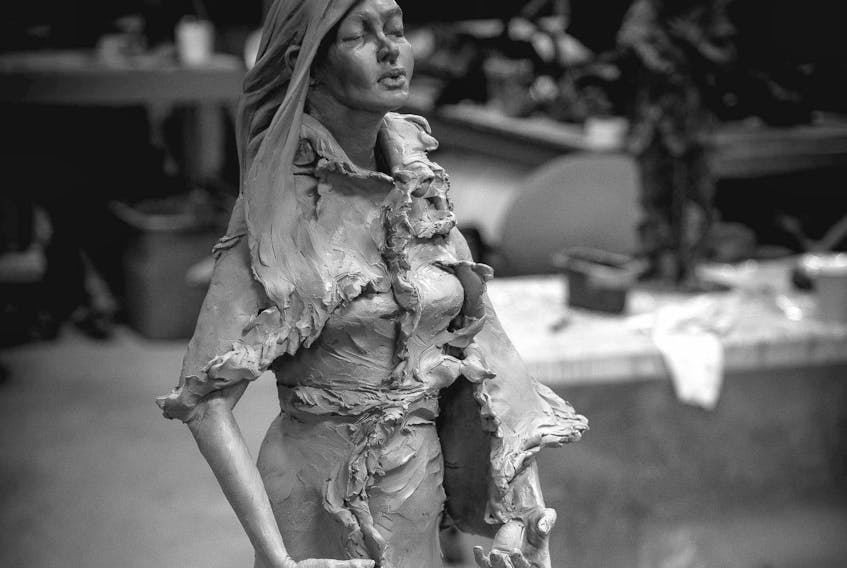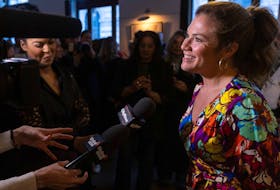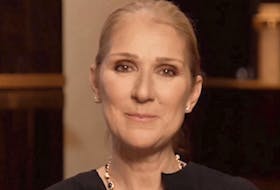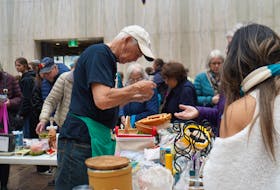TORONTO, ONT. - Composer Dean Burry has been interested in using opera to tell the story of Shawnadithit for a very long time.
Growing up in Gander, Burry was surrounded with information of the woman widely known as the last of the Beothuk people, but when he began to think more about it, he realized that he didn’t like the way she was usually depicted. The story of her as a meek figure, led around and studied, didn’t give her any power. He wanted to explore a narrative that presented her as a person in her own right rather than just in relation to her captors.
“When I moved to Toronto to do my master’s, I wrote a short opera about Shawnadithit’s capture. That was in 1995,” Burry said. “I wrote the libretto and got my master’s, but I realized that it wasn’t the right way to do the story. So the project sat for a while.”
About 12 years ago, he rewrote the synopsis but felt as if he didn’t have enough information about the complex issues involved, so he put it away again until a few years ago when discussion of Canada 150 celebrations brought even more Indigenous viewpoints to light.
“I approached Tapestry Opera here in Toronto, they have a history of supporting work with important social issues,” Burry said. “They decided this is a story that needs to be told so they went with it.”
“When you remember someone into the air, when you say her name, she continues on. She is not disappeared, she is not extinct. She exists because we say her name, she exists because we expose her work to the world."
- Yvette Nolan
Burry then approached Algonquin playwright Yvette Nolan to work with him on the project as the librettist – the person who creates the narrative, the lyrics, of an opera. Nolan says the project came along at just the right time.
“When Canada 150 was happening, which of course is really problematic for Indigenous people on this land, Dean Burry phoned me, and asked, ‘What do you think about trying to do this opera together?’
“It was kind of in response to the whole idea of Canada and what that meant and the idea of Indigenous people disappearing or not.”
Nolan felt that it made sense for them to tell Shawnadithit’s story together right now.
“I knew of her, of course, from my position as an Indigenous person in this country. Dean knew of her as a Newfoundlander,” Nolan said. “Because this idea of Canada is about all of us living here together it was kind of a perfect match. You know, white guy from Newfoundland and Indigenous person from the East. My mom’s people are from Kitigan Zibi’ which is Quebec, just north of Ottawa.”

A familiar story
While many people, especially in Newfoundland and Labrador, know at least some of the story of Shawnadithit, it has only been in relation to her as a captive; it has not been truly her story. Nolan and Burry feel it is past time for her perspective to be told.
Andy Barker, the Exploits Ward Councillor for Qalipu First Nation and former columnist for The Advertiser, agrees that it is time for these stories to reach a wider audience.
“It’s interesting that Shawnadithit’s name is coming to the forefront now, that we are getting a better understanding of her people and of who she might have been,” Barker said. “It will be valuable for understanding people that have been disappeared and the people who are still here. It’s a link to the past and to the people of today.”
Nolan sees opera as an excellent medium for the scope of the story they are telling.
"Opera is big, it is epic, and the story of this land is epic and the story of the relationship between the first people and those who came after is also epic,” Nolan said. “Opera allows us access into people’s hearts in a different way than regular plays."
Burry agrees.
“Different forms of art affect you differently. Opera at its most can overwhelm the senses,” he said. “It is the most exciting and visceral form of storytelling you can get.”
To some, opera might be a strange choice for telling the story of an Indigenous person, but Burry feels it is quite fitting.
“I have always embraced Newfoundland stories. I have written six Newfoundland operas. It’s one way to really connect with Newfoundland and to keep those stories.”
-Dean Burry
“So much First Nations art combines music, storytelling, dance in one,” he said. “Opera does the same thing.
“Opera is just storytelling using every art form - a very intense form of storytelling. It’s the original multi-media art form.”
Once they had agreed to work together, Nolan and Burry decided to bring in more Indigenous artists to work with Shawnadithit’s drawings to bring the story to life.
The approach
“Because I’m not Beothuk, and because all we have left of her is those sketches, I thought it would be interesting to have different Indigenous artists interpret what she left us,” Nolan said. “We generated a list of artists we’d love to work with who might be interested in responding to the work that Shawnadithit left us.”
For Burry, bringing in these Indigenous artists is a respectful approach to interpreting the story of a culture that is not his own.
“Those drawings are Shawnadithit’s voice,” Burry said. “We cannot go to elders and ask permission to tell this story.”
Barker says that it makes sense to use Shawnadithit’s drawings to help tell the story of her people.
“It is very valuable to have her information, her drawings,” he said. “If we didn’t have those, we would have no information directly from the Beothuk people.”
The Indigenous artists who are working on the project include choreographer Michelle Olson, and visual artists Jordan Bennett, Lori Blondeau and Jerry Evans.
Burry and Nolan are both very much enjoying the collaboration.
“I’m working with a big group of wonderful Indigenous artists,” Burry said. “This is all about finding what we have in common.”
“I want them to primarily to be transformed, to be moved in some way. I want them to be moved to look at their own histories and what they think they know and what might be there that they haven’t realized before. Not just this particular story about this particular people in Newfoundland, but wherever they are.”
- Yvette Nolan
Nolan says the process feels rooted in an Indigenous sense of community.
"Once we started bringing in all these Indigenous artists to interpret different moments, it popped open like a community,” Nolan said. “It is very much Indigenous in terms of 'it takes a community' and in building community and everyone having their own truth inside these stories, so it’s been great."
The process of creating this opera is a lengthy one. Aside from the work that Burry has returned to over and over, Nolan has done extensive research and writing. In addition to their partnership with Tapestry Opera, they are working with Opera on the Avalon in St. John’s. The team has already done a libretto workshop with Marion Newman, the Kwagiulth and Stó:lo First Nations, English, Irish and Scottish mezzo-soprano who will star in the opera, as well as a music workshop.
“We did a music workshop, and exploration with the soundscape,” Burry said. “When I thought about central N.L., I realized that while Shawnadithit and I obviously grew up in very different cultures, we grew up in that same physical environment. So I incorporate beach and wind sounds in the music.”
The team plans to do a full workshop with the full musical score at a later date.

A new interpretation
Burry is pleased to have finally found a way to present Shawnadithit’s story in an empowering way.
“I have always embraced Newfoundland stories. I have written six Newfoundland operas,” he said. “It’s one way to really connect with Newfoundland and to keep those stories.”
Nolan sees a real opportunity to reach audiences and make them think.
“I want them to primarily to be transformed, to be moved in some way.” Nolan said. “I want them to be moved to look at their own histories and what they think they know and what might be there that they haven’t realized before. Not just this particular story about this particular people in Newfoundland, but wherever they are.”
Nolan hopes that the audience will open their minds to a different perspective on long-held beliefs.
“What stories do they think they know that are actually one side of the story or only one perception of the story?” she said. “So, that they are like ‘Oh, what I learned in my school book was not enough.’ So maybe they start seeing things in a different way.
Nolan, who says she loves working in the opera form, values the opportunity to help Shawnadithit to live on.
"It’s been great... When you remember someone into the air, when you say her name, she continues on. She is not disappeared, she is not extinct. She exists because we say her name, she exists because we expose her work to the world."
The opera will premiere in Toronto in May 2019 and will come in St. John’s the following June.
Related stories:









